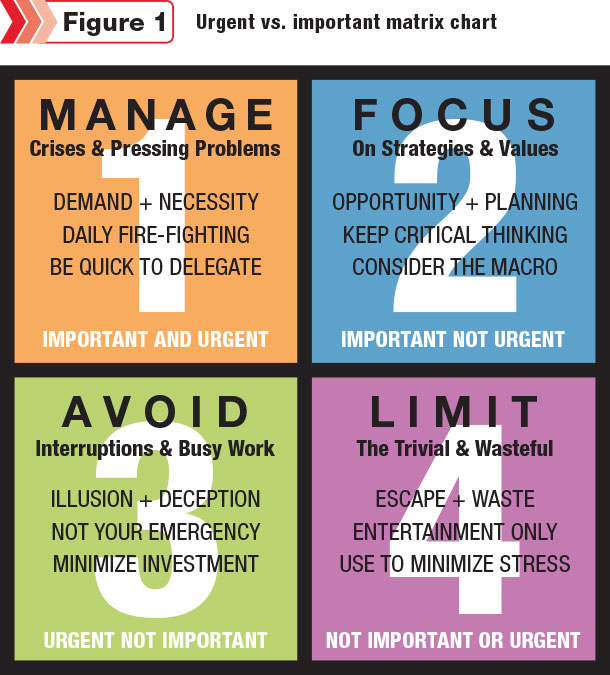Most readers have likely seen some variation of the urgent vs. important matrix chart accompanying this article. It continues to intrigue me, however, how many dairy producers are never quite able to effectively discipline themselves to allocate any (or virtually no) time toward the long-term planning function of management.
While it is not at all unusual for planning to be depicted in the top-right quadrant of the matrix (important, not urgent), it seems that many producers conveniently translate not urgent to, “I’ll get to it next month.”

My interest regarding this apparent dynamic is further instilled by the number of these same dairy farms that freely acknowledge planning is, in fact, very important to the long-term success of their businesses.
Equally perplexing is the seeming lack of acknowledgement that the less time they spend in Quadrant 2, the more frequent and intense the fires become, consuming too much of their management time in Quadrant 1 doing firefighting rather than other, more productive functions.
Why do so many of us fail to adequately plan? I believe the following to be among the primary reasons why it is so tempting to procrastinate various aspects of business planning:
- Some dairy producers have been relatively successful without any real planning. These same farms are often blessed with a family member (usually someone in the most senior generation of ownership) who possesses a great gut instinct for managing cows or the checkbook.
- Already mentioned but very much a factor: Some managers simply have not made it a priority and therefore do not create windows of time for planning. In other words, they do not have a system for planning.
- A significant number of producers have grown up in a culture of crisis management accompanied by little or no business planning – and therefore have defaulted to that style of management.
- Nearly all of us have some fear of the unknown and are sometimes tempted to ignore or sweep under the rug that which we fear. The future is a pretty big mystery, but be mindful that we have to plan in advance precisely because of the unfamiliar and unpredictable events and markets we will ultimately have to face (and survive).
- Too many producers are solely focused on results. These are the guys who are constantly chanting, “get ’er done” but are not always paying close attention to whether they are getting the right things done.
- It’s not uncommon to hear the following criticism of business planning: “What’s the point of planning when everything will be different in just a couple years?” These detractors are missing the point that business planning is not a “one-and-done” process. Planning is a constant and very dynamic endeavor.
Why is business planning important?
Remember the advertising tagline, “This isn’t your father’s Oldsmobile?” Well, this isn’t your father’s dairy industry either, and that alone is one of the most provocative reasons why business planning is so increasingly important. Market volatility has drastically changed how dairy farm businesses must be managed. Consolidation continues to both create and demand greater production efficiencies.
In recent years, we have seen many dairy farms searching for (and finding) enhanced revenue streams through branding, on-farm processing and agritourism. Even more importantly, cash management has become equally important as overall profit margins to the long-term success of most dairy farms in the U.S.
We have to position ourselves to carry enough liquidity forward in the good years to survive the next really tough year. All of these changing dynamics do nothing but add to the complexity of successfully navigating already challenging waters.
I recently received a phone call from a prospective client who was inquiring about my practice. He said something very reminiscent of many previous conversations I’ve had with dairy producers from across the country.
He commented: “We haven’t changed anything around here for quite a while, and I guess it’s time that we get a better handle on where we are and where we need to go.” If you’ve ever had similar contemplations, perhaps they are another reason for effective business planning.
How do we develop and refine our plans?
Believe it or not, it really isn’t a difficult process. For most farms, the most challenging steps in moving forward will be shedding the worn-out rationale in the aforementioned bullet points. As with many implementation processes, it probably will be best to walk before you run. Here are some steps you can take to begin a journey toward meaningful business planning:
Set aside individual time to plan
Start small – pick the day of your week which is typically the least busy and commit to taking 15 minutes immediately after your first meal of the day for planning. Use the time to reflect and deliberate on your long-term business blueprint. For example:
- Brainstorm business strategies
- Develop wish lists for future capital investments and improvement projects
- Make note of desired elements of your succession plan
- Research market risk advisers who could provide meaningful guidance
Over time, you will begin to see value in this process and want to invest more time toward meaningful business planning.
Set aside group time to plan
It has always amazed me how dairy families spend so much time together and yet invest 99.9 percent of it talking about daily tasks. I know that everyone’s to-do list is always full, and there is much that needs to be done, but spend a sliver of your time together dreaming and discussing future needs, wants and desires.
Commit to meeting with all family/co-owners once a month to discuss strategic issues, opportunities and matters other than current fires and immediately pressing tasks.
Enlist support – create a team
Many farms already have some kind of team in place but too often lose momentum and get bogged down in firefighting. Gather a small team of trusted advisers along with other co-owners on an annual basis for the sole purpose of visioning, goal-setting and short- and long-term planning.
In addition to the more traditional operational team members (nutritionist, veterinarian, agronomist), make sure you include individuals who are proficient in risk management, finance, law and taxation. The stronger your team is, the greater your chances are of creating an energizing and sustainable plan.
There is at least one more very good reason to embrace business planning. Think about “thriving,” not just “surviving.” I encourage you to think about the subtle and not-so-subtle differences between these two characterizations of business ownership.
Don’t be satisfied with just surviving – although this alone is becoming increasingly difficult. Envision how you want and need your business to look 15 to 20 years from now and purposely begin planning to achieve those goals. PD
Greg Squires is with Dairy Enterprise Services. Email Greg Squires .






